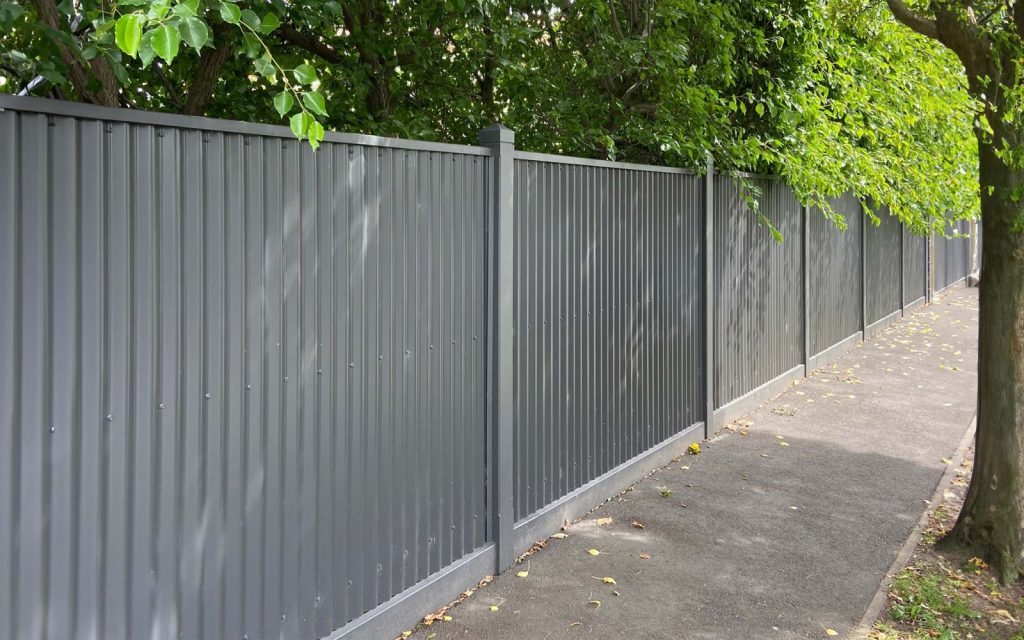
Choosing between Colorbond and timber fencing is an important decision for homeowners and businesses alike.
As a fencing contractor with extensive experience across various types of fencing – residential and commercial – I’ve worked with both materials and can guide you through their strengths and limitations.
This article breaks down the key differences between Colorbond vs timber fencing, so you can make an informed decision for your Wollongong property.
Table of Contents
- Colorbond Fencing
- Traditional Timber Fencing
- Colorbond vs Timber Fencing: Key Factors to Consider

Colorbond Fencing
Colorbond fencing, constructed from high quality steel with a protective coating, has become a popular choice for those seeking durability and modern aesthetics. This material offers several distinct advantages:
- Durability and Longevity: One of the standout benefits of Colorbond is its strength. Built to withstand Australia’s harsh weather conditions, including high winds and intense sun, this steel fencing won’t warp, rot, or suffer from termite damage like timber. It typically lasts over 20 years with minimal signs of wear.
- Low Maintenance: Once installed, Colorbond fencing requires almost no maintenance. Unlike timber, which needs regular sealing and painting, a quick wash is enough to keep Colorbond looking new. This is particularly beneficial in Wollongong’s coastal areas, where salty air can deteriorate other materials faster.
- Security and Privacy: The solid steel construction provides an unmatched level of security and privacy. With no gaps between panels, Colorbond effectively blocks out prying eyes and offers excellent noise reduction, making it ideal for both residential and commercial settings.
- Customisation Options: Available in 22 colour options, Colorbond fencing suits a wide variety of design preferences. Whether you’re looking to blend with natural surroundings or make a bold statement, the choices are abundant.
- Environmentally Friendly: Made from recyclable materials, Colorbond fencing is a sustainable choice for eco-conscious property owners. It doesn’t rely on wood, reducing the demand for deforestation.
Traditional Timber Fencing
Timber fencing remains a popular choice for many, especially those seeking a natural look to complement their garden or property. However, while timber brings certain advantages, it also comes with notable challenges:
- Aesthetic Appeal: Timber’s biggest selling point is its natural appearance. Its rustic charm appeals to many property owners, especially in rural or heritage areas. Timber fences can be painted or stained to suit individual preferences, and no two timber fences ever look exactly the same.
- Customisation: Timber is easily customisable, allowing for various heights, shapes, and designs. From classic picket fences to larger, solid privacy panels, timber offers flexibility that Colorbond doesn’t.
- Maintenance Requirements: One downside to timber fencing is the significant maintenance it requires. Over time, timber needs regular staining, sealing, and painting to protect it from the elements. In Wollongong, where coastal air and moisture can accelerate timber decay, frequent upkeep is essential to avoid rot, mould, and termite infestations.
- Durability: While timber can last between 10 to 15 years with proper care, it is less durable than Colorbond. Timber is susceptible to cracking, warping, and termites, which can quickly degrade its condition. Extra measures, such as termite treatments, are necessary for longevity.
- Environmental Considerations: In the comparison of Colorbond vs timber fencing, while timber is a natural product, sustainable timber options should be considered to ensure the wood is harvested responsibly. Even then, the environmental impact of timber may be higher compared to steel, as it contributes to deforestation and has a shorter lifespan.

Why Choose Our Fencing Services
- Expertise in All Fencing Types: Whether you’re after Colorbond, timber, aluminium, or pool fencing, our team has extensive experience in both residential and commercial projects.
- Custom Solutions for Every Property: We tailor our fencing solutions to meet your specific needs, ensuring both function and aesthetic appeal for your Wollongong property.
- Quality Materials: We use only high quality materials like premium Colorbond steel and sustainably sourced timber to ensure longevity and value for money.
- Free Quotes and Honest Pricing: We offer transparent pricing with no hidden costs. Get a free, no-obligation quote for your next fencing project.
- Reliable, Local Service: As a local Wollongong fencing contractor, we understand the unique environmental challenges in the area and provide solutions that last.
For more information or to request a free quote, contact us today!
FAQs
In the debate of Colorbond vs timber fencing, Colorbond fencing is made from steel, offering greater durability and lower maintenance compared to timber, which is more susceptible to wear and tear but provides a natural aesthetic.
When comparing Colorbond vs timber fencing, timber is cheaper initially, but Colorbond is more cost-effective over time due to its low maintenance and long lifespan.
In the comparison of Colorbond vs timber fencing, Colorbond fencing typically lasts over 20 years, while timber fencing can last 10 to 15 years with proper care.
In the comparison of Colorbond vs timber fencing, timber fencing requires regular staining, sealing, and occasional repairs due to its susceptibility to weathering and termites.
When comparing Colorbond vs timber fencing, Colorbond is often seen as more environmentally friendly due to its recyclability and long lifespan, whereas timber requires sustainable sourcing to minimize environmental impact.
